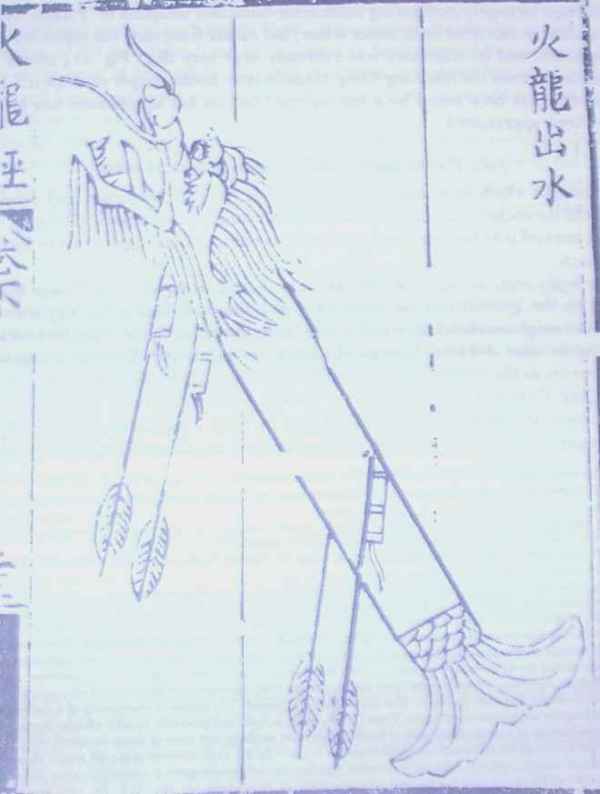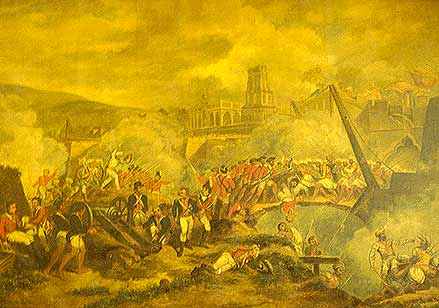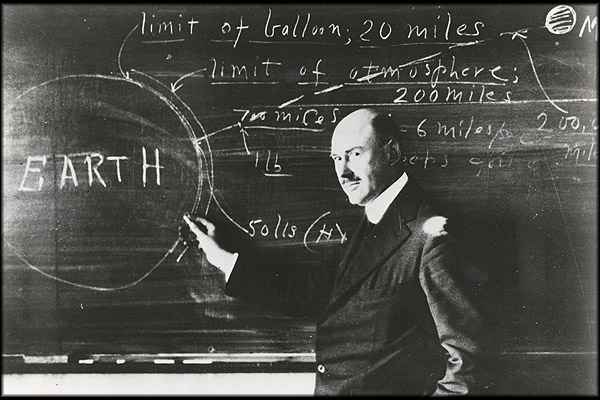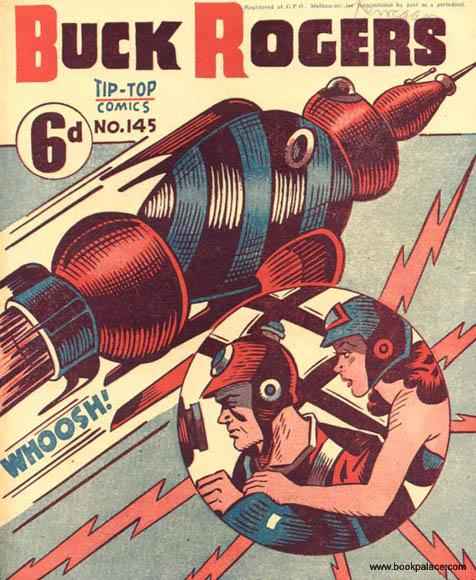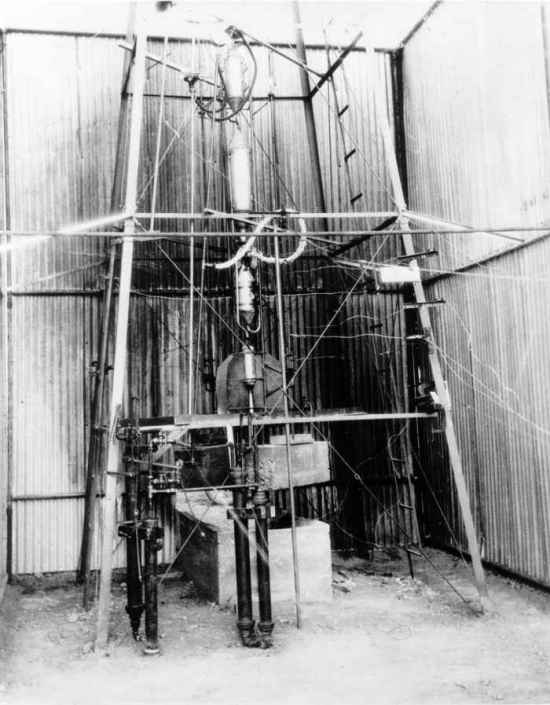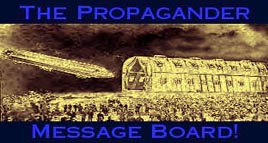



160 CE
: Icaromenippus.
From Cosmos by Carl Sagan: Like organisms, machines also have their evolutions. The rocket began, like the gunpowder that first powered it, in China where it was used for ceremonial and aesthetic purposes. Imported to Europe around the fourteenth century, it was applied to warfare, discussed in the late nineteenth century as a means of transportation to the planets by the Russian schoolteacher Konstantin Tsiolkovsky, and first developed seriously for high-altitude flight by the American scientist Robert Goddard.
The German V-2 military rocket of World War II employed virtually all of Goddard’s innovations and culminated in 1948 in the two-stage launching of the V-2/WAC Corporal combination to the then unprecedented altitude of 400 kilometers. In the 1950s, engineering advances organized by Sergei Korolov in the Soviet Union and Wernher von Braun in the United States, funded as a delivery systems for weapons of mass destruction, led to the first artificial satellites.
The pace of progress has continued to be brisk: manned orbital flight, humans orbiting, then landing on the moon, and unmanned spacecraft outward bound throughout the solar system. Many other nations have now launched spacecraft, including Britain, France, Canada, Japan, and China--the society that invented the rocket to begin with.
1045: The first record of using a chemical substance as a propellant for a primitive rocket pops up in ancient China. Until this time, various Chinese sources have recorded the use of "fire arrows," a term somewhat too ambiguous to determine whether or not the chroniclers meant rockets, or arrows carrying a flammable substance. "Fire sticks," bamboo tubes filled with saltpeter, sulfur, and charcoal, have previously been in the arsenals of many a Chinese warlord. (Temple, Crosby)
1232 Battle of Kai-fung-fu: The Chinese use bamboo casings loaded with gun powder mixed with iron shrapnel, and aimed as projectiles against an invading Mongol army. From an eye-witness account: "When the rocket was lit, it made a noise that resembled thunder that could be heard for five leagues--about 15 miles. When it fell to Earth, the point of impact was devastated for 2,000 feet in all directions." Image by Charles Hubbell. (Needham)
December 25, 1241: After their experience at Kai-fung-fu, the Mongols develop rockets and other weapons of their own derived from gun-powder, and, on this day, use them for the first time against Magyar forces at the battle of Sejo. The technology is subsequently introduced in Europe. (Gruntman)
1248: The first mention of gunpowder in Europe is in Roger Bacon's Epistola, De Secretis Operibus Artis et Naturae et de Nullitate Magiae Note: The last ingredient is either in code or the result of garbled text in the original document.:We can, with saltpeter and other substances, compose artificially a fire that can be launched over long distances . . . . By only using a very small quantity of this material much light can be created accompanied by a horrible fracas. It is possible with it to destroy a town or an army . . . . In order to produce this artificial lightning and thunder it is necessary to take saltpeter, sulfur, and Luru Vopo Vir Can Utriet. (Temple)
February 15, 1258: Mongol invaders use rockets to capture Baghdad. (Crosby, Chase)
1264: A "ground-rat," a primitive type of firework and one of the earliest devices utilizing internal-combustion rocket propulsion, horribly frightens guests at a feast held by the Emperor Lizong. Reportedly, the Empress-Mother Kung Sheng, in whose honor the feast is being held, is the most frightened of all. (Needham)
1268 Seventh Crusade: Arab forces use rockets against forces under the command of King Louis IX of France. (Chase)
1350: The first mention of a multi-stage rocket (in this case, a rocket launching-tube coupled with a fire lance) is in the Huolongjing, or Fire Dragon Manual, a military treatise compiled during the early Ming Dynasty. Note: The illustration above is from the Huolongjing.
One uses a bamboo stick 4 ft 2 in long, with an iron (or steel) arrow-head 4.5 inches long ... behind the feathering there is an iron weight 0.4 inches long. At the front end there is a carton tube bound on to the stick, where the "rising gunpowder" is lit. When you want to fire it off, you use a frame shaped like a dragon, or else conveniently a tube of wood or bamboo to contain it. (Needham, Temple)
1429 Hundred Years War: The French Army uses rockets against the English at the siege of Orleans. (Chase, Norris)
1500: According to ancient legend, a Chinese official of the Ming dynasty named Wan-Hoo attempted a flight to the moon using a large wicker chair to which were fastened 47 gunpowder-powered bamboo rockets. Forty seven assistants, each armed with torches, rushed forward to light the fuses. In a moment there was a tremendous roar accompanied by billowing clouds of smoke. When the smoke cleared, the flying chair and Wan-Hu were gone.
1540: The First Science Fiction Story?
1650: Polish artillery expert, Kazimierz Siemienowicz, publishes a series of drawings illustrating a multi-staged rocket. (Chase, Burrows)
July 5, 1687: The Philosophae Naturalis Principia Mathematica by English astronomer Sir Isaac Newton, first lays out the basic principles governing gravity and motion. (Gruntman)
1780 Battle of Guntur: Rockets are used by Indian troops against the British Army. Image by Charles Hubbell. (Civilization)
April–May 1799: Tippu Sultan, ruler of the Kingdom of Mysore, uses rockets against the British East India Company during the battle of Seringapatam. (Crosby)
1813: British mathematician William Moore publishes Treatise on the Motion of Rockets, the first exposition of rocket mechanics based on Newton's Third Law of Motion.
August 24, 1814: The British 85th Light Infantry uses rockets against an American rifle battalion during the Battle of Bladensburg. An eye-witness, British Lieutenant George R. Gleig, records: "Never did men with arms in their hands make better use of their legs." (Civilization, Glover)
September 7, 1814: 35-year-old amateur poet, Francis Scott Key, writes the poem "Defense of Fort McHenry" after witnessing the bombardment of Fort McHenry in Baltimore, Maryland, by the rockets and artillery of Royal Navy ships off Chesapeake Bay. The poem will later be set to music and renamed "The Star-Spangled Banner." (Glover)
December 4, 1846: The US Army's first battalion of rocketeers accompanies Major General Winfield Scott's expedition against Mexico. The battalion consists of 150 soldiers with about 50 rockets. (Gruntman)
March 24, 1847: At the siege of Veracruz, the new US rocket battery is used against the Mexican Army for the first time.
April 8, 1847: Captain Robert E. Lee fires off 30 rockets during the battle for Telegraph Hill. After the completion of the war against Mexico, the US rocketeer battalion is disbanded, and their rockets put in storage.
1861: With the outbreak of Civil War, the US rockets are removed from storage but found to be unusable. New models are soon developed and deployed. (Burrows)
July 3, 1862: Major General J.E.B. Stuart's Confederate cavalry fires rockets at Major General George B. McClellan's Union troops at Harrison's Landing, Va.
1864: Union troops defending Charleston, SC, record that their rockets are "especially practical in driving off Confederate picket boats, especially at night." (Crosby)
1865: Jules Verne's From the Earth to the Moon is published.
October 5, 1882: Rocket pioneer Robert Hutchings Goddard is born in Worcester, Massachusetts. (Goddard)
1898: The novel War of the Worlds, by H. G. Wells, is published. 16-year-old Robert Goddard will find the story of an alien invasion from the planet Mars "inspirational."
October 19, 1899: A 17-year-old Robert Goddard, climbing into a cherry tree to prune branches, finds himself daydreaming instead of pruning: "It was one of the quiet, colorful afternoons of sheer beauty which we have in October in New England, and as I looked toward the fields at the east, I imagined how wonderful it would be to make some device which had even the possibility of ascending to Mars, and how it would look on a small scale, if sent up from the meadow at my feet." For the rest of his life Goddard will observe this day as "Anniversary Day." (Goddard)
1865: H. G. Wells' First Men in the Moon is published.
1902: Inspired by Jules Verne's From the Earth to the Moon and H. G. Wells' First Men in the Moon, the first Science Fiction film--A Trip to the Moon (Le Voyage dans la Lune)--is released to a delighted public. It stars French director and master magician Georges Melies, who also designed the sets and costumes, directed, photographed, and produced the film. The image of the lunar capsule landing in the eye of the moon is an icon of cinematic history.
1903: The Exploration of Cosmic Space by Means of Reaction Devices is published by Russian rocket scientist Konstantin Tsiolkovsky. (Harford, Riper)
1904: Robert Hutchings Goddard delivers his class oration as valedictorian, On Taking Things for Granted:
Just as in the sciences, we have learned that we are too ignorant safely to pronounce anything impossible, so for the individual, since we cannot know just what are his limitations, we can hardly say with certainty that anything is necessarily within or beyond his grasp. Each must remember that no one can predict, to what heights of wealth, fame, or usefulness he may rise, until he has honestly endeavored; and he should derive courage from the fact that all sciences have been, at some time, in the same condition as he, and that it has often proved true that the dream of yesterday is the hope of today and the reality of tomorrow.
January 12, 1906: Sergey Pavlovich Korolyov, the future "Chief Designer" of the Soviet space program during the Cold War, is born. He is often cited as the father of practical astronautics. (Harford)
1908: Robert Goddard receives a B.S. in physics from Worcester Polytechnic Institute. Note: Goddard will receive his M.A. from Clark University in 1910 and his Ph.D. at Clark in 1911. (Goddard)
March 23, 1912: Wernher Magnus Maximilian Freiherr von Braun is born in Wirsitz.
May 15, 1914: US rocket scientist Robert H. Goddard receives two important patents; one for a multi-stage rocket and one for a rocket powered with liquid nitrous oxide and petrol. (Burrows, Riper, Gruntman)
January 1917: Robert Hutchings Goddard is awarded a five-year grant from the Smithsonian Institution, totaling $5,000.
Winston Churchill, 1917: It is improbable that any terrorization of the civil population which can be achieved by air attack could compel (force) the government of a nation to surrender. Air offensives should consistently be directed at military and communication centres.
1919: A Method of Reaching Extreme Altitudes by Robert Goddard is published. The book will heavily influence the work of rocket pioneers Sergey Korolev, Hermann Oberth, and Wernher von Braun. (Gruntman, Riper, Piszkiewicz)
January 10, 1920: The Versailles Treaty takes effect, sharply limiting the ability of the defeated Germans to develop or deploy a whole range of weapons systems, from submarines to aircraft. However, the signers of the Treaty neglect to make any mention whatsoever of rockets. Research into missile technology thus by default gains a legal basis and will be vigorously explored during the ensuing Weimar Republic.
January 11, 1920: The Smithsonian Institution announces that Professor Robert H. Goddard of Clark College has invented and tested a new type of multiple-charge, high-efficiency rocket of entirely new design which opens up "the possibility of sending recording apparatus to moderate and extreme altitudes within the earth's atmosphere ... the new rocket apparatus would go straight up and come straight down." The announcement goes a step further, however, and proposes to send "to the dark part of the new moon a sufficiently large amount of the most brilliant flash powder which, in being ignited on impact, would be plainly visible in a powerful telescope. This would be the only way of proving that the rocket had really left the attraction of the earth as the apparatus would never come back."
January 13, 1920: From The New York Times:
As a method of sending a missile to the higher, and even highest, part of the earth's atmospheric envelope, Professor Goddard's multiple-charge rocket is a practicable, and therefore promising device. Such a rocket, too, might carry self-recording instruments, to be released at the limit of its flight, and conceivable parachutes would bring them safely to the ground. It is not obvious, however, that the instruments would return to the point of departure; indeed, it is obvious that they would not, for parachutes drift exactly as balloons do. And the rocket, or what was left of it after the last explosion, would have to be aimed with amazing skill, and in dead calm, to fall on the spot where it started.
But that is a slight inconvenience, at least from the scientific standpoint, though it might be serious enough from that of the always innocent bystander a few hundred or thousand yards away from the firing line. It is when one considers the multiple-charge rocket as a traveler to the moon that one begins to doubt and looks again, to see if the dispatch announcing the professor's purposes and hopes says that he is working under the auspices of the Smithsonian Institution. It does say so, and therefore the impulse to do more than doubt the practicability of such a device for such a purpose must be well, controlled. Still, to be filled with uneasy wonder and express it will be safe enough, for after the rocket quits our air and and really starts on its longer journey, its flight would be neither accelerated nor maintained by the explosion of the charges it then might have left. To claim that it would be is to deny a fundamental law of dynamics, and only Dr. Einstein and his chosen dozen, so few and fit, are licensed to do that.
That Professor Goddard, with his "chair" in Clark College and the countenancing of the Smithsonian Institution, does not know the relation of action to reaction, and of the need to have something better than a vacuum against which to react--to say that would be absurd. Of course he only seems to lack the knowledge ladled out daily in high schools.
But there are such things as intentional mistakes or oversights, and, as it happens, Jules Verne, who also knew a thing or two in assorted sciences--and had, besides, a surprising amount of prophetic power--deliberately seems to make the same mistake that Professor Goddard seems to make. For the Frenchman, having got his travelers to or toward the moon into the desperate fix riding a tiny satellite of the satellite, saved them from circling it forever by means of an explosion, rocket fashion, where an explosion would not have had in the slightest degree the effect of releasing them from their dreadful slavery. That was one of Verne's few scientific slips, or else it was a deliberate step aside from scientific accuracy, pardonable enough of him in a romancer, but its like is not so easily explained when made by a savant who isn't writing a novel of adventure.
All the same, if Professor Goddard's rocket attains a sufficient speed before it passes out of our atmosphere--which is a thinkable possibility--and if its aiming takes into account all of the many deflective forces that will affect its flight, it may reach the moon. That the rocket could carry enough explosive to make on impact a flash large and bright enough to be seen from earth by the biggest of our telescope--that will be believed when it is done. See: July 17, 1969.Every vision is a joke until the first man accomplishes it; once realized, it becomes commonplace. -- Robert Hutchings Goddard
December 15, 1923: German rocket enthusiast, Hermann Oberth, self-publishes a rejected doctoral thesis, By Rocket into Planetary Space (Die Rakete zu den Planetenraumen). (Burrows, Gruntman)
1924: The first Soviet rocket club, the Society for Studies of Interplanetary Travel, is founded by Konstantin Tsiolkovsky, Friedrich Zander, and Yuri Kondratyuk.
1924: Twelve year-old Wernher von Braun is arrested for causing a disturbance on a crowded street in Berlin. The boy had been apprehended after detonating a handful of fireworks that he had attached to a toy wagon. (Braun)
June 21, 1924: Goddard weds Esther Christine Kisk, a secretary in the President's office of Clark University.
1925: Thirteen year-old Wernher von Braun is inspired when he reads Hermann Oberth's book By Rocket into Interplanetary Space. (Piszkiewicz, Braun)
March 16, 1926: The first US rocket program begins as Robert H. Goddard launches a 4-foot high rocket named "Nell," the world’s first liquid-fueled rocket, to an altitude of 41 feet, a speed of 60 miles per hour, and a distance of 152 feet. Goddard: "It is difficult to say what is impossible, for the dream of yesterday is the hope of today and the reality of tomorrow." (Goddard, Gruntman)
1927: The Society for Space Travel (Verein fuer Raumschiffahrt—VfR) is formed in Germany. Such early German rocket pioneers as Johannes Winkler (above), Rudolf Nebel, Fritz von Opel, and Maximilian Valier are founding members. Wernher von Braun will join in 1930. (Piszkiewicz, Cornwell)
August 1928: Philip Francis Nowlan's novella, Armageddon 2419 A.D., published in the American pulp magazine Amazing Stories, introduces the iconic rocket-powered hero Buck Rogers to the universe. (Dille, Burrows)
1929: Fritz Lang’s monumental film, Woman in the Moon (Frau im Mond) is released to an enthusiastic public and rave reviews. One of Lang's theatrical effects, the creation of the cinematic devise of a backward countdown from ten to one to heighten suspense, will become a standard part of real rocket launches. (Piszkiewicz)
1929: The incredibly popular comic strip, Buck Rogers in the 25th Century, written by John Flint Dille and drawn by Dick Calkins (based on Philip Nowlan's novella Armageddon 2419 A.D.), blasts off in America's newspapers. (Dille)
Ray Bradbury, from the Introduction to Buck Rogers, The First 60 Years in the 25th Century: What was the world like then? It was a world without one small rocket, or the promise of one. Oh, yes, later on we were to remember there were a few wild men like Professor Goddard stirring about. But no one gave him mind. He was a blathering idiot, a fool, a nothing. Von Braun? He was a teenager somewhere in Germany smitten with Fritz Lang's film Girl in the Moon, starting a cuckoo rocket society, standing out under the stars at night, a has-been who would never be. And, in 1929, think of it! Why, good grief, Armstrong, Aldrin and Collins hadn't even been born yet!
In 1929 you would have found few decent roads and no really good cross-continental highways . . . . The first streamlined trains were merely in blueprint stage. No one had broken the sound barrier. In fact, it was impossible of breakage, and anyone who dared to try his spunk against the gods of aerodynamics would be shattered like so much porcelain. That much was fact. That much was truly known. Passenger air service across the country? A few thousand people had the money. The other 120 million took the train, departed the color of milk, arrived the color of soot.
If you had a million dollars in those days you couldn't have bought, much less found, a tape recorder. Television? We would invent that in the year 1999, maybe. Radio? The merest infant, born only a few years before. Films, also, had begun to speak up, use sound, a few scant months before Dick Calkins sat down to draw Buck Rogers . . . . In 1929, our thinking was so primitive we could scarcely imagine the years before a machine capable of ‘footprinting’ moon dust would be invented. And even that prediction was snorted at, declared impossible by 99 percent of the people. And Buck Rogers offered us more: a trip to the asteroids, a journey to Venus, Mercury, and, yes, Jupiter itself.1929: Famed aviator Charles Lindbergh arranges for a $50,000 grant to rocket scientist Robert Goddard from the Guggenheim Fund for the Promotion of Aeronautics.
December 30, 1930: Roswell, New Mexico, sees the first launch ever of a liquid-fueled rocket, courtesy of Robert Goddard. Goddard has moved his team to New Mexico, where he will work in near isolation and secrecy for a dozen years, at the insistence of the Massachusetts Fire Marshall. Note: After a 1929 test flight, a local Worcester newspaper had carried the mocking headline "Moon rocket misses target by 238,799 1/2 miles." (Gruntman, Burrows)
Robert Hutchings Goddard: It is not a simple matter to differentiate unsuccessful from successful experiments . . . . [Most] work that is finally successful is the result of a series of unsuccessful tests, in which difficulties are gradually eliminated.
1930: Berlin's rocket launch station, Reinickendorf, is founded by Rudolf Nebel to test a series of Mirak's (Minimum Rockets) utilizing a solid rocket fuel invented by Hermann Oberth. (Cornwell)
1931: Sergey Korolyov, together with space travel enthusiast Friedrich Zander, founds the Jet Propulsion Research Group (GIRD), one of the earliest state-sponsored centers for rocket development in the USSR. In May 1932 Korolyov will be appointed chief of the group. (Harford
March 14, 1931: Johannes Winkler launches Astris, Europe's first liquid-fuel rocket. (Burrows, Piszkiewicz)
September 26, 1931: The Assembly of the League of Nations adopts a General Convention to improve the Means of Preventing War.
April 19, 1932: Robert Goddard tests the first rocket to be equipped with a gyroscopic guidance system. (Gruntman)
Wernher von Braun: Goddard's name was known in German rocketry circles in those pre-Hitler days. In speeches aimed at popular support for spaceflight, he was frequently cited as an example of how farsighted people were in other countries; in particular, America.
June 1932: Wernher von Braun is recruited by the German Army’s Weapons Agency for its rocket research program located at Kummersdorf near Berlin. (Cornwell, Piszkiewicz, Braun)
July 1932: Captain Walter Dornberger, director of the rocket research group of the German Army, witnesses a test launch of a Mirak rocket. (Piszkiewicz, Burrows)
October 1, 1932: Twenty-year-old Wernher von Braun begins employment with the German Army's Experimental Station, Kummersdorf West (Versuchstelle Kummersdorf West), near Berlin. (Cornwell, Piszkiewicz, Braun)
We needed money for our experiments and, since the [German] army was ready to give us help, we did not worry overmuch about the consequences in the distant future. Besides, in 1932, the idea of another war was absurd. The Nazis were not then in power. There was no reason for moral scruples over the use to which our researches might be put in the future. We were interested in only one thing: the exploration of space. Our main concern was how to get the most out of the Golden Calf.
January 30, 1933 Machtergreifung: Hitler is appointed Chancellor of Germany.
I was still a youngster in my early 20's and frankly didn't realize the significance of the changes in political leadership. My father was wiser. He had been what corresponds to Secretary of Agriculture under President von Hindenburg, but quit all public offices when Hitler came to power. He warned me that it was all going to end in tragedy for Germany and many other people too. But I was too wrapped up in rockets to heed his warning. -- Wernher von Braun1933: German rocket scientist Wernher von Braun begins work on the Aggregat 1 (A1) and Aggregat 2 (A2) programs with permanent, on-going funding; the first rocket program anywhere ever to be fully funded. (Braun, Burrows, Piszkiewicz)
1933: Von Braun joins the SS (Schutzstaffel) horseback riding school. (Braun)
1933: Seven years after Robert Goddard's first little-publicized launch in 1926, Sergey Korolyov's GIRD in the USSR launches a liquid-fueled rocket, GIRD-X, powered by a hybrid fuel of solid gasoline and liquid oxygen. (Harford)
August 3, 1933 Science Fact Article: Getting More Light on the Moon.
October 31, 1933: The Soviet Government merges the GIRD organization with the Gas Dynamics Laboratory (GDL) in Leningrad. The merger creates the Jet Propulsion Research Institute (RNII), headed up by the military engineer Ivan Kleimenov. This merged group contains a number of people who are enthusiastic proponents of space travel, including Valentine Glushko. Sergey Korolyov becomes the Deputy Chief of the institute, where he will lead the development of cruise missiles and of a manned rocket-powered glider. (Harford)
1934: The USSR's Sergey Korolyov publishes Rocket Flight in Stratosphere.
April 6, 1934: Josef Goebbels, the Reich Propaganda Minister, decrees that the publication of any stories concerning rocket technology research be banned. (Piszkiewicz)
July 27, 1934: Wernher von Braun is awarded a doctorate in physics (aerospace engineering), but his doctoral thesis, Construction, Theoretical, and Experimental Solution to the Problem of the Liquid Propellant Rocket (dated April 16, 1934), is suppressed by the German military. It will not actually be published until 1960. (Braun)
December 1934: Wernher von Braun makes his first successful test launch of an A-2 rocket powered by liquid oxygen and ethanol. (Braun, Burrows)
March 1, 1935: Goering is appointed Commander-in-Chief of the German Air Force.
March 28, 1935: Goddard's A-5 successfully achieves supersonic velocity and an altitude of 1.46 km, using his new guidance system.
August 1935 Wehchaftmachung: Hitler begins rearmament in earnest.
November 7, 1936: Wernher von Braun's team tests the first clustered liquid-fueled rocket with mixed results. (Braun, Piszkiewicz)
1936–1937: Peenemuende, located on the Baltic island of Usedom, is taken over by the German army and the air force, and developed as a secret test range and research base for von Braun's team. Note: This location is chosen partly on the recommendation of von Braun's mother, who had recalled her father's duck-hunting expeditions there. (Braun)
January 3, 1937: Hitler speaks before the Reichstag:
The Four-Year Plan will give permanent employment to those workmen who are now being released from the armament industry. It is significant for the gigantic economic development of our people that there is today a lack of trained workmen in many industries. There will be no strikes or lockouts in Germany, because everyone has to serve the interests of the entire nation. Education of the people will never come to an end, and this education includes the Hitler Youth, the Labor Service, the Party, and the Army...
May 1, 1937: Von Braun joins the Nazi Party. (Piszkiewicz)
Wernher von Braun: It was officially demanded that I join the National Socialist Party. At this time (1937) I was already technical director of the Army Rocket Center at Peenemunde . . . . My refusal to join the party would have meant that I would have to abandon the work of my life. Therefore, I decided to join. My membership in the party did not involve any political activities ... in Spring 1940, one SS-Standartenfuehrer (SS Colonel) Mueller ... looked me up in my office at Peenemunde and told me that Reichsfuehrer-SS Heinrich Himmler had sent him with the order to urge me to join the SS. I called immediately on my military superior ... Major-General W. Dornberger. He informed me that ... if I wanted to continue our mutual work, I had no alternative but to join.
March 12, 1938 Anschluss: The German Army marches unopposed into Vienna.
June 1938: The GAU (Main Artillery Directorate) of the Red Army founds the RNII (Soviet Jet Propulsion Research Institute) in Leningrad. Its mission is to develop a multiple rocket launcher weapons system.
June 22, 1938: During the Great Purge, the NKVD arrests Sergey Korolyov. His colleagues, Ivan Kleymenov, Georgy Langemak, and Valentin Glushko have denounced him. He is accused of deliberately slowing the work of the research institute Following torture in the Lubyanka prison to extract a confession, he is tried, and sentenced to ten years in a labor camp. Korolyov will later learn that Glushko had denounced him, and this may have been the cause of the life-long animosity between the two men. Andrei Kostikov, who became the head of RNII after its leadership was arrested, had reportedly denounced Glushko and Korolev. (Harford)
September 29, 1938 Muenchen Konferenz: The Munich Conference concludes.
March 23, 1939: Adolf Hitler meets with Walter Robert Dornberger and his team at the Versuchstelle Kummersdorf West, near Berlin, to be briefed on developments in rocketry.
From Wernher von Braun, The Man Who Sold the Moon by Dennis Piszkiewicz: March 23, 1939, should have been a very big day for Wernher von Braun. It was his twenty-seventh birthday, and it was also the day he would first meet Nazi Germany's Fuehrer, Adolf Hitler. Hitler had been persuaded to be personally briefed on the German Army's rocket development program. The briefing, however, would not take place at the elaborate development base at Peenemuende, but at the old Kummersdorf West facility, just seventeen miles south of the Fuehrer's Reich Chancellery at the center of Berlin. Walter Dornberger, as the Army officer in charge of developing liquid-fueled rockets, led a tour of the facility. He showed Hitler and his entourage the static firing of a 650-pound-thrust rocket motor, and a 2,200 pound-thrust engine. They then met Wernher von Braun, who gave the Fuehrer a lecture on the systems and operations of their rockets, using a cutaway A-3 as a model. This was followed by a static demonstration of an A-5, which had its skin and fins removed to show its systems in operation. Dornberger concluded the briefing by telling Hitler about the A-4, the advanced weapon that had yet to be built.
After discussing the Army's Aggregate series of rockets over lunch, Hitler commented, "Es war doch gewaltig!" which translated as, "Well, it was grand!" or, in colloquial English, "That was swell!"
Walter Dornberger took Hitler's comment as faint praise for the Army's rockets, but he may have been optimistic. Hitler may have been commenting on the quality of his lunch of mixed vegetables and mineral water.
Dornberger later expressed his surprise that Hitler did not seem impressed by the ear-shattering demonstrations of rocket motors, the complex rocket mechanisms, or the plans for the future. Hitler's skepticism was, of course, justified. Dornberger and von Braun had spent tens of millions of marks, yet they had not successfully fired a rocket for over four years, not since the launching of the A-2's in December 1934.
April 1939 Projekt P.1065: Plans are laid down for what will become the Me 262, the world's first operational turbojet fighter aircraft.
1939: Toward the end of the year, Sergey Korolyov, who has lost most of his teeth due to the labor camp's brutal conditions, is reassigned to a "sharashka," a type of penitentiary for intellectuals. This is essentially a slave-labor camp where scientists and engineers work on projects assigned by the Communist party leadership. During World War II, this sharashka will design both the Tupolev Tu-2 bomber and the Petlyakov Pe-2 dive-bomber. The group will be moved several times during the war, the first time to avoid capture by advancing German forces. (Harford)
September 3, 1939 Der zweite Weltkrieg: WW2 begins as Britain, Australia, New Zealand and France declare war on Nazi Germany.










Click to join 3rdReichStudies
Disclaimer:The Propagander!™ includes diverse and controversial materials--such as excerpts from the writings of racists and anti-Semites--so that its readers can learn the nature and extent of hate and anti-Semitic discourse. It is our sincere belief that only the informed citizen can prevail over the ignorance of Racialist "thought." Far from approving these writings, The Propagander!™ condemns racism in all of its forms and manifestations.
Fair Use Notice: The Propagander!™ may contain copyrighted material the use of which has not always been specifically authorized by the copyright owner. We are making such material available in our efforts to advance understanding of historical, political, human rights, economic, democracy, scientific, environmental, and social justice issues, etc. We believe this constitutes a "fair use" of any such copyrighted material as provided for in section 107 of the US Copyright Law. In accordance with Title 17 U.S.C. Section 107, the material on this site is distributed without profit to those who have expressed a prior interest in receiving the included information for research and educational purposes. If you wish to use copyrighted material from this site for purposes of your own that go beyond 'fair use', you must obtain permission from the copyright owner.







